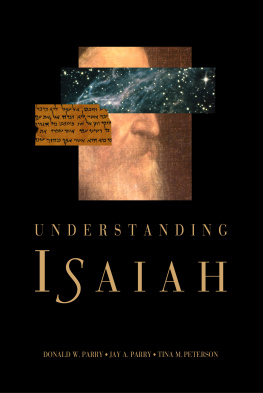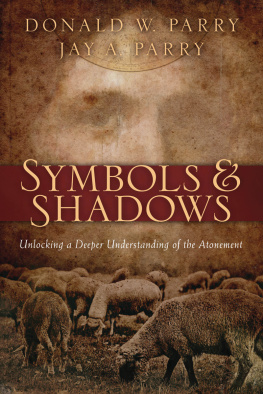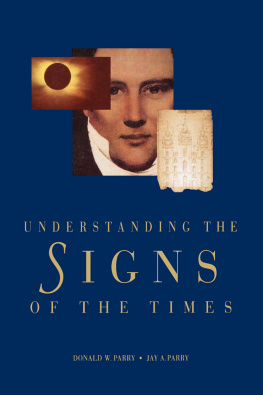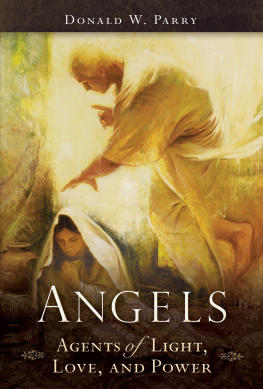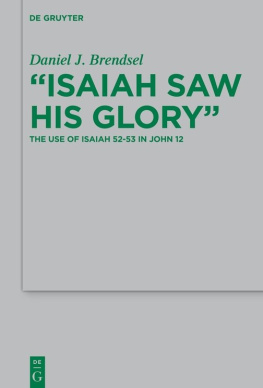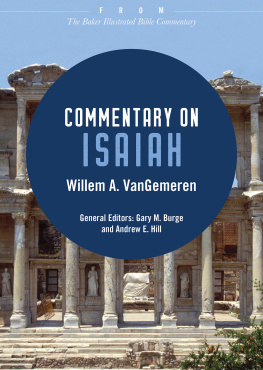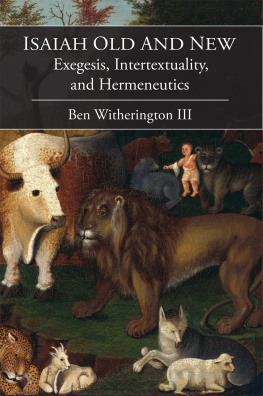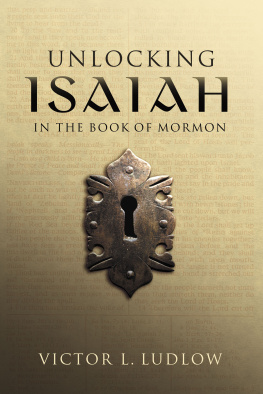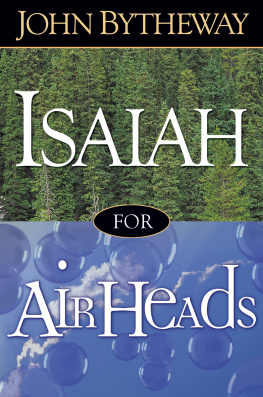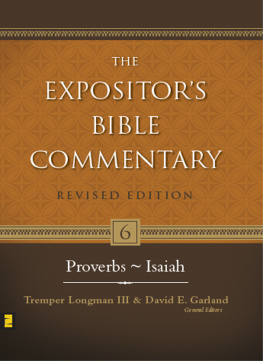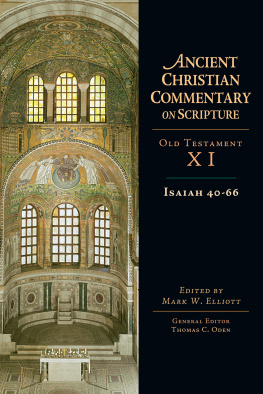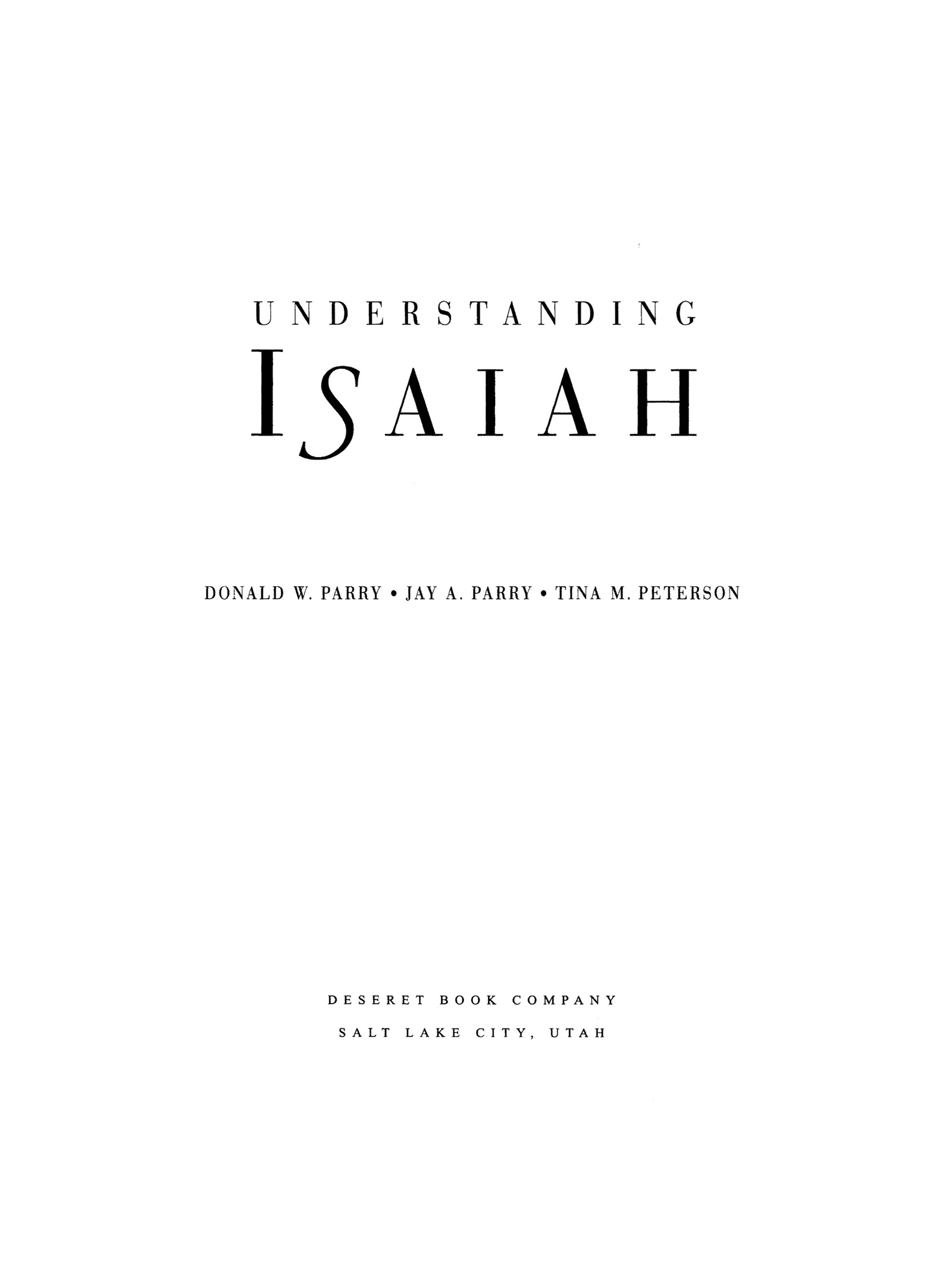1998 Donald W. Parry, Jay A. Parry, and Tina M. Peterson
All rights reserved. No part of this book may be reproduced in any form or by any means without permission in writing from the publisher, Deseret Book Company, P. O. Box 30178, Salt Lake City, Utah 84130. This work is not an official publication of The Church of Jesus Christ of Latter-day Saints. The views expressed herein are the responsibility of the author and do not necessarily represent the position of the Church or of Deseret Book Company.
DESERET BOOK is a registered trademark of Deseret Book Company.
Visit us at DeseretBook.com
First printing in hardbound 1998.
First printing in paperbound 2009.
Library of Congress Cataloging-in-Publication Data
Parry, Donald W.
Understanding Isaiah / Donald W. Parry, Jay A. Parry, Tina M. Peterson. p. cm.
Includes bibliographical references and index.
ISBN-10 1-57345-361-7 (hardbound)
ISBN-13 978-1-57345-361-5 (hardbound)
ISBN-13 978-1-60641-081-3 (paperbound)
1. Bible. O.T. IsaiahCommentaries. 2. Christian lifeMormon authors. I. Parry, Jay A. II. Peterson, Tina M., 1965 . III. Title.
BS1515.3.P37 1999
224.1077dc21 98-15654
CIP
Printed in the United States of America
10 9 8 7 6 5 4
R. R. Donnelley and Sons, Harrisonburg, Va

ACKNOWLEDGMENTS
We appreciate many individuals who have contributed in a variety of ways to this volume. We gratefully acknowledge the review of portions of the manuscript by dedicated colleagues at Brigham Young University: Robert L. Millet, dean of Religious Education; Stephen D. Ricks, professor of Hebrew and Semitic languages; and Richard D. Draper, Victor L. Ludlow, Joseph Fielding McConkie, and Stephen E. Robinson, professors of ancient scripture. Debra Parker and Melissa Proctor examined portions of an early draft of the manuscript and offered significant and helpful suggestions. We thank Rebecca Chambers, Allison Clinger, Alison Coutts, Vicki Parry, and Shirley Ricks for their proficient editorial work; Susan Southworth and Annaka Parry for typing; Ruth Howard and John Peterson for source checking; and Justin Parry for proofreading the manuscript.
The staff at Deseret Book has done much to turn this work from manuscript into finished book. Were grateful for the leadership of Sheri Dew and Kent Ware and the excellent editorial services of Suzanne Brady and Emily Watts. Others who have brought their considerable professionalism to the task of helping to create a complex book are Ronald 0. Stucki, art director; Patricia J. Parkinson, typographer; and Jennifer Pritchett, editorial assistant. Though this work has required the assistance of these and other people, the authors alone are responsible for its content.

LIST OF ABBREVIATIONS
| BHS | Biblia Hebraica Stuttgartensia |
| DSS | Dead Sea Scrolls |
| GNB | Good News Bible |
| JB | Jerusalem Bible |
| JST | Joseph Smith Translation of the Bible |
| KJV | Holy Bible, Authorized King James Version |
| LB | Living Bible |
| LXX | Septuaginta |
| MT | Holy Scriptures according to the Masoretic Text |
| NAB | New American Bible |
| NEB | New English Bible |
| NIV | New International Version of the Holy Bible |
| NKJV | Holy Bible, New King James Version |
| NRSV | Holy Bible, New Revised Standard Version |
| RSV | Holy Bible, Revised Standard Version |

INTRODUCTION
GREAT ARE THE WORDS OF ISAIAH
Most of us as members of the Church know that we have been commanded to diligently search the words of Isaiah. And most of us agree that that is a hard thing to do. Isaiah is indisputably one of the most challenging books in the Bible. We probably wouldnt feel as intimidated if we had been given the special commandment to search Third Nephi or the book of Luke or most of the sections of the Doctrine and Covenants. But Isaiah seems to have been written for another time and place, in a form and language that sometimes seem to defy understanding. In fact, it is common to hear Latter-day Saints say, Ive read First Nephi a dozen times, but I just cant seem to make it through Second Nephi.
What makes Second Nephi so different from First Nephior any of the other books in the Book of Mormon? One difference is the Isaiah sections, which Nephi quoted because of their importance and with which we struggle because of their complexity.
TOOLS FOR UNDERSTANDING
This book provides a set of tools to help remedy that situation. After all, much of the book of Isaiah was written for our time. The following tools are included:
The Book of Mormon and the Joseph Smith Translation have been used to create a more correct, inspired version of the King James rendering of Isaiah.
The text of Isaiah has been put back into what may have been Isaiahs original formata poetic style called parallelism, in which matching phrases repeat the same idea in different words. Seeing Isaiahs words in this form makes them much easier to understand.
The chapters are divided into separate units of thought, to help us make more sense of each part.
Each chapter begins with ideas of how that chapter can be likened unto us and our time.
Helpful background is provided for the many unique words and symbolisms Isaiah used.
A phrase-by-phrase (sometimes word-by-word) commentary is given for the entire bookall sixty-six chapters. This commentary is based principally on the words of the prophets, both ancient and modern.
It is our desire to make Isaiah accessible to members of the Church in many situations and at many educational levels. As you, the reader, apply these tools to your own study, we believe you will begin to understand Isaiah as never beforeand will begin to feel for yourself that great are the words of Isaiah (3 Ne. 23:1).
ISAIAH, THE MAN AND HIS WORLD
Isaiahs name means Jehovah is salvation. How fitting that a man who devoted his life to testifying of the saving power of the Messiah should also have a name that so testified.
Many scholars believe that Isaiahs ministry took place between the years 740 and 700 (or perhaps 699) B.C.approximately forty years. According to Isaiah 1:1, Isaiah served as a prophet during the reign of several kings in Judah, including Uzziah, Jotham, Ahaz, and Hezekiah. He had personal dealings with at least two of those kings. According to one ancient Jewish source, Isaiahs wife was a daughter of one of the kings of Judah, making Isaiah a member of the royal family by marriage.
Isaiahs wife is called prophetess in Isaiahs record (8:3), suggesting that she too had the gift of revelation. Isaiah and his wife had at least two sons who served as signs to Israel, as did Isaiah and his wife themselves. Behold, I and the children whom the Lord hath given me are for signs and for wonders in Israel from the Lord of hosts (8:18). As we discuss in the commentary on Isaiah 8, Isaiah stood as a type of God the Father; the prophetess was a type of Mary, the mother of Christ; and one of their sons was a type of Jesus Christ.

